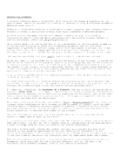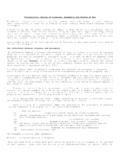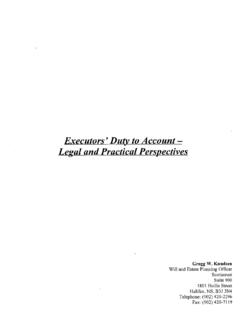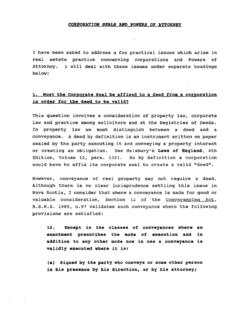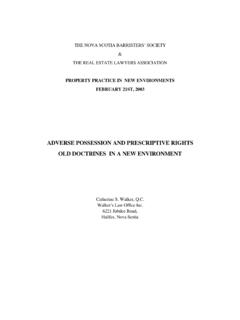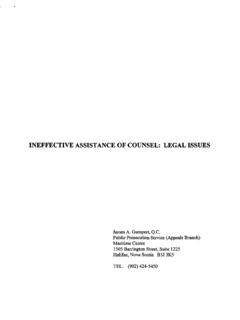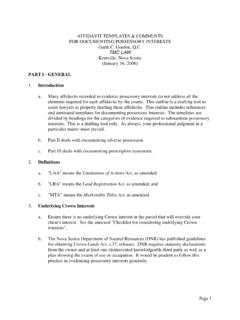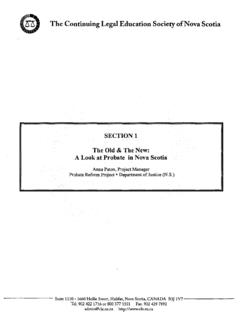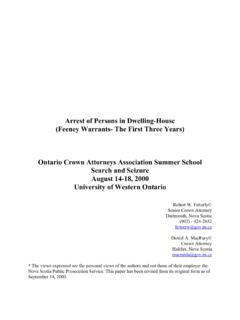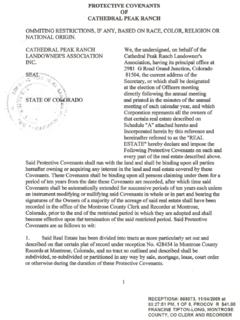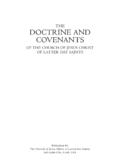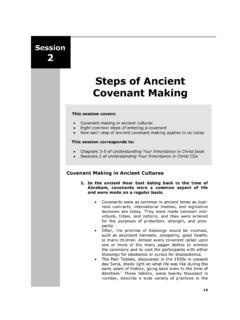Transcription of RESTRICTIVE COVENANTS - NSBS Home
1 RESTRICTIVE COVENANTS . A covenant affecting land is RESTRICTIVE if it restricts the doing of something to, on, over or under land or in relation to an estate or interest in land: Elphinstone - COVENANTS Affecting Land, page 5. Normally, a RESTRICTIVE covenant is contained in a deed conveying land, although there is nothing to prevent a RESTRICTIVE covenant from being created by a separate document. At first glance, one might ask why this subject is being included in a course on "Practical Property", since the above description of a RESTRICTIVE covenant appears to rest on contractual rather than property principles. If A conveys land to B, and in the deed B, in consideration of the conveyance, agrees not to use the land for purposes other than residential purposes, does not the usual requirement of privity of contract apply, and if this requirement is not met, can it not be said that A only has a remedy against B if B breaches this covenant , unless there is a voluntary assumption of liability for its breach by B's successors in title to the land?
2 This was the case until 1848 when Tulk v. Moxha (1848), 41 was decided. Until that time, it was possible for A, who had the benefit of the covenant , to assign the benefit of the covenant to the purchaser when he sold the property, but, in the absence of a voluntary assumption of liability on the covenant by subsequent purchasers of the land the benefit of the covenant would be practically useless, the covenant being designed, as it was, to enhance the value of the property retained by A by restricting the use of the neighbouring property originally conveyed to B. As D. J. Donahue pointed out in his book the Conveyancer's Guide to Real Estate Practice in Ontario, at pages 72-73, "A RESTRICTIVE covenant is a contract between two neighbouring land owners by which the covenantee, anxious to maintain the saleable value of his property, acquires the right to restrain the covenantor from putting his land to certain specified uses.". At common law, therefore, the purchaser of a property, the use of which was restricted by covenant , could, with full knowledge of the covenant , purchase the property and ignore the restriction, and nevertheless be free from all liability for its breach, and, by the same token, the person who made the covenant could sell the property in question the next day at a profit and free from the restriction.
3 As a result, the courts of equity intervened in Tulk v. Moxhay (supra). In that case, the covenant under consideration was a covenant by the purchaser of property which included Leicester Square to maintain Leicester Square as a garden. A successor in title to the purchaser cleared the entire area of vegetation and the original covenantee brought an action against him to restrain this breach of the covenant . The court pointed out how inequitable the result would be if the covenantee was left without a remedy when it said, at page 1144: " ..nothing could be more inequitable than that the original purchaser should be able to sell the property the next day for a greater price in consideration of the assignee being allowed to escape from the liability which he had himself undertaken.". The Court, in this case, treated the covenant not only as a contract but also as an interest in real property appurtenant to the land owned by the covenantee, or the person having the benefit of the covenant originally, which burdens or encumbers the title to the land owned by the person who originally gave the undertaking under the covenant .
4 RESTRICTIVE COVENANTS which benefit land and burden other land, therefore, are akin to easements, since there must be both a dominant tenement, that is, the land to be benefited, and a servient tenement, that is, the land to be burdened. However, in order for a RESTRICTIVE covenant to have this effect, certain conditions must be met. These I conditions are correctly described at page 52 of Elphinstone - COVENANTS Affecting Land, as follows: (a) The intention of the parties that the benefit of the covenant should be capable of passing with the land to be benefited, must appear from the instrument creating the covenant ;. (b) the covenant must have the object of protecting land which, at the date of the covenant belongs to, and after the date of the covenant , is retained by, the covenantee;. (c) at the dates of the covenant and of the conveyance or assignment and at the date of the breach complained of, the covenant must be capable of protecting the land intended to be protected; and (d) the land intended to be protected must be described by the instrument creating the covenant so as to be ascertainable with reasonable certainty.
5 The covenant must also be negative in substance: Zetland v. Driver [1939] Ch. 1. Let us examine each one of these characteristics more closely. The first characteristic, that is, the characteristic that the parties intended that the benefit and burden of the covenant should be capable of passing with the title must appear either expressly or by implication in the document creating the covenant . In order for a covenant to have the second characteristic, that is, have the object of protecting land, it must "touch or concern" the land. As pointed out by Farwell, J., in Rogers v. Hosegood [1900] 2 Ch. 388, at page 395. "Adopting the definition of Bailey, J., in Congleton Corporation v. Pattison (1808), 10 East 130, 135, the covenant must either affect the land as regards mode of occupation, or it must be such as per se, and not merely from collateral circumstances, affects the value of the land". Accordingly, a RESTRICTIVE covenant burdening one property must be capable of benefiting another property.
6 For example, a covenant that property shall be used only for residential purposes clearly benefits, and enhances the value of the property which is intended to be benefited, notwithstanding who the owner of that property may be. It is because of this principle that a covenant which is expressed to benefit lot A. by restricting the use of lot B, which may be many miles away, is probably not enforceable. Thus, if A owns property in the south end of the City of Halifax and owns another property in the north end of the City, sells the property in the north end, and purports to include a covenant in the deed for the benefit of the south end property to the effect that the north end property will be used for residential purposes only, that covenant is clearly incapable of actually benefiting the south end property, notwithstanding what the parties intended, and is therefore only enforceable between the original parties and not between the successors in title to the south end property and the north end property.
7 The next characteristic of a RESTRICTIVE convenant which runs with land, it will be recalled, is that the land intended to be protected or benefited must be described by the instrument creating the covenant so as to be ascertainable with reasonable certainty, although a full legal description is probably not necessary if the property is otherwise identifiable with reasonable certainty: In Re Union of London and Smith's Bank Limited [1933] Ch. 611, 631. Finally, a covenant which runs with land must be negative in substance. This is so because the remedy for a breach is injunctive in nature and the courts are reluctant to grant injunctions which require the doing of positive acts which require continuous supervision by the courts. However, a covenant may be positive in form but negative in substance. For example, in Tulk v. Moxhay (supra), a covenant which was positive in form, providing, as it did, that the covenantor would maintain Leicester Square as a garden, was held to be negative in substance as actually being a covenant not to use the property for any purpose other than as a garden.
8 In addition to meeting these general conditions, when drafting RESTRICTIVE COVENANTS , one should also keep in mind the following considerations: (a) A RESTRICTIVE covenant which forbids the sale, mortgage or lease of land is void and unenforceable under the general principle that any restriction on alienation is void if it is designed to prevent the exercise of a power, such as the power of alienation, which is inherent in the ownership of a legal estate in fee simple: Shaw v. Ford (1877) 7 Ch. D. 669 at page 674. (b) If a covenant is intended to protect only a part of the land described, and is only expressed as benefiting all the land described, but is actually capable of benefiting only part of that land, it does not run with all the land notwithstanding that it may be capable of benefiting a part of it. For example, in the case In Re Ballard's Conveyance [1937] Ch. 473 where the covenant was with the owner of the Childwickbury Estate, which consisted of 1700 acres, there were no words such as "all or any of the lands" to indicate that the benefit of the covenant was to pass by a conveyance of a part of the land.
9 Accordingly, Clauson, J. held that while the covenant might touch or concern a small portion of the Childwickbury Estate, it did not touch or concern the remainder of it and that the covenant could not be severed and treated as annexed to that part of the land as was actually touched by or concerned by the covenant . He did, however, say this (at page 481): "In Rogers v. Hosegood the benefit of the covenant was annexed to all or any of certain lands adjoining or near to the covenantor's land and no such difficulty arose as faces me here; and there are many other resported cases in which, for similar reasons, no such difficulty arose.". What are the practical considerations which result from these principles? First of all, let us place ourselves in the position of a solicitor for a client who is planning to sell part of his property and to protect the property being retained by him, for all time, by creating a RESTRICTIVE covenant which will burden the land which he intends to sell and benefit the land which he intends to retain.
10 He must determine whether' the covenant is (a) capable of benefiting the land to be retained, regardless of who the owner may be, and (b) contrary to the policy of the law, such as a restriction on alienation. Once the solicitor has satisfied himself on these points, he should ensure that the deed contains a covenant which is negative, that the deed clearly expresses an intention that the burden and benefit run with the title to both lots A and B, and that the problem which arose in the case In Re Ballard's Conveyance (supra) is avoided by using the words suggested by the Court in that Accordingly, the deed should contain a covenant which could be in the following form: To the intent that the benefit of the following covenant runs with and to the benefit of all or any of the lands described in Schedule A and the owner, owners, occupier or occupiers from time to time of such lands, and that the burden of that covenant runs with and burdens all or any of the lands described in Schedule B, the grantee, his heirs, executors, administrators, successors and assigns covenant with the grantor, his heirs, executors, administrators, successors and assigns as follows: (Here insert negative covenant ).
